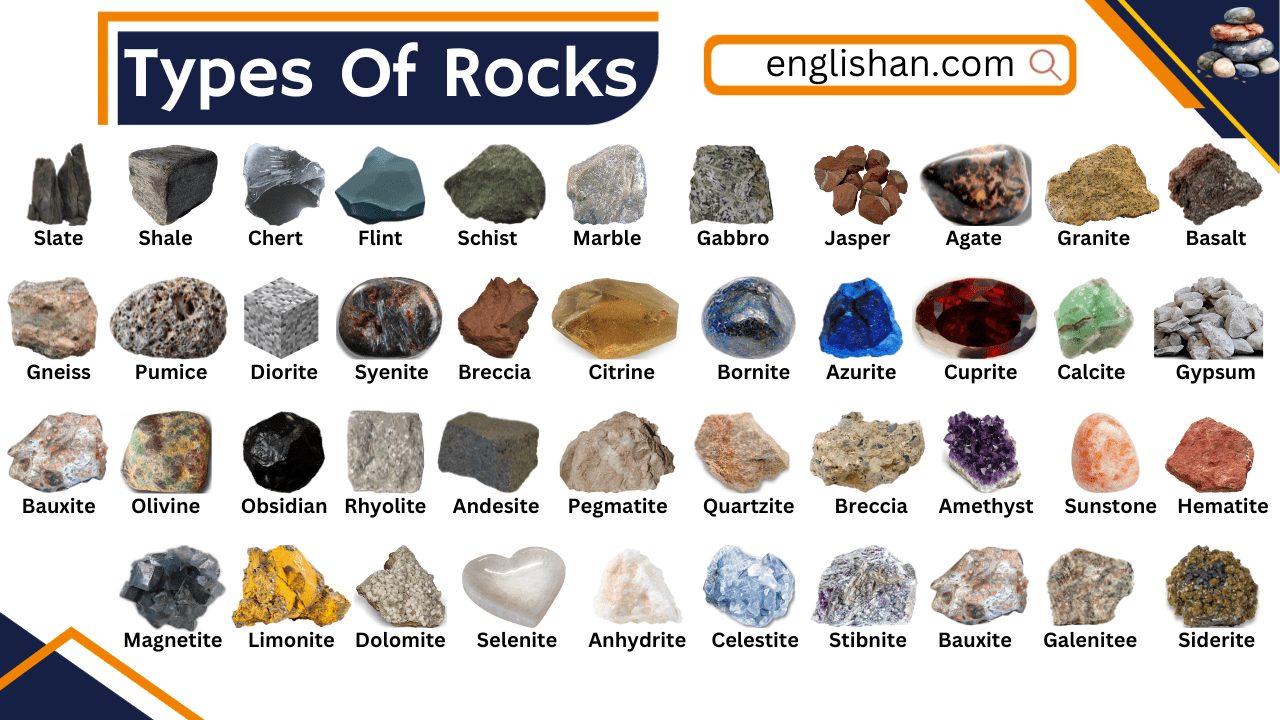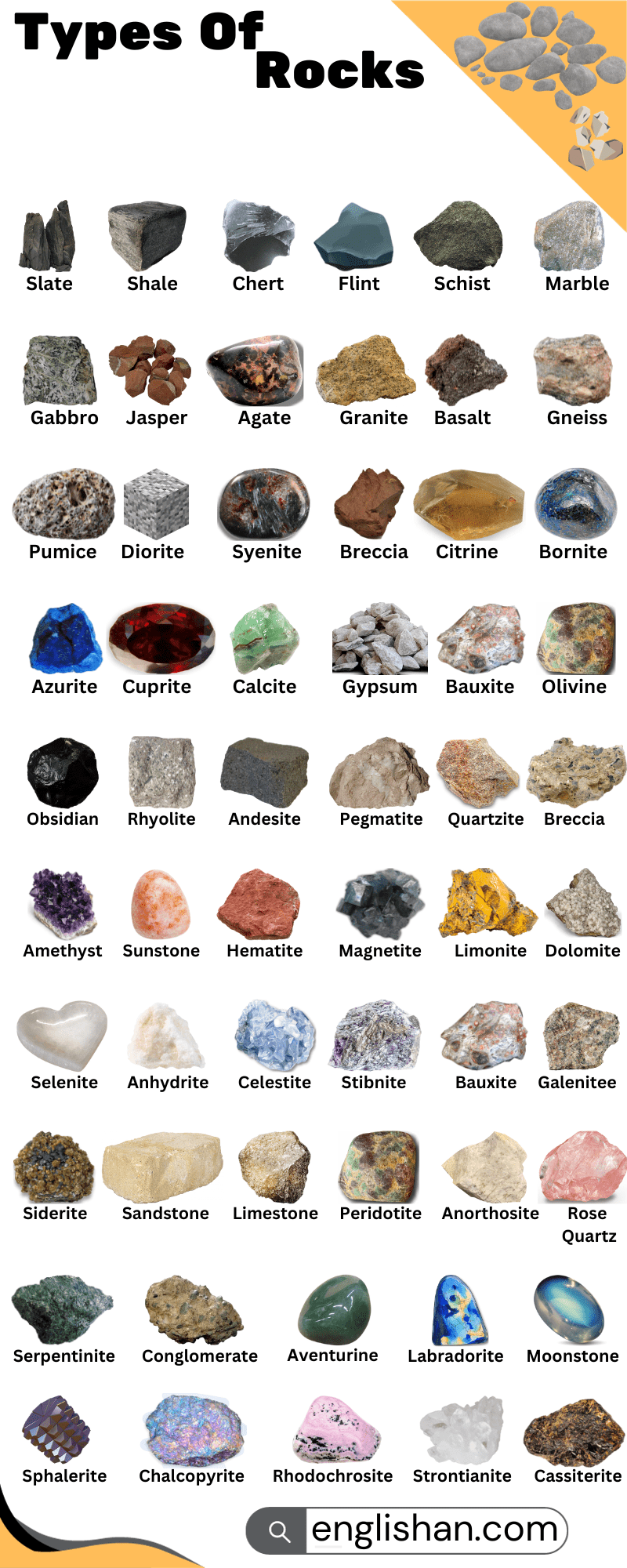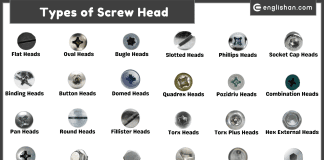Contents
Learn the Names of Rocks through pictures: Talking about rocks is a subject that is likely to come up frequently in any language and English is no different. In this section, you are going to learn all the vocabulary that you will need to talk about the types of rock.
What are Rocks?
Rocks are like the building blocks of the Earth’s outer layer, called the crust. They’re made naturally and are solid. Imagine them as a mix of tiny mineral pieces, some other special materials, and even things from plants and animals.
These rocks are like history books for the Earth. They tell us a lot about what happened long, long ago and how the Earth has changed. Scientists study rocks to understand the story of our planet.
So, rocks are important because they give us clues about the past and help us figure out the amazing processes that shaped the Earth.
Types of Rocks
Have you ever looked at rocks and wondered where they come from? Well, rocks have interesting stories about how they are made. Let’s learn about the different kinds of rocks and how they come into existence.
There are three main types of rocks: Igneous, Sedimentary, and Metamorphic.
Igneous Rocks:
Definition: Igneous rocks form from the cooling and solidification of molten rock, either below the Earth’s surface (intrusive) or on the surface (extrusive).
Examples:
- Granite: Coarse-grained, light-colored rock composed mainly of quartz, feldspar, and mica.
- Basalt: Fine-grained, dark volcanic rock often forming lava flows.
- Andesite: Intermediate volcanic rock with a mix of dark and light minerals.
- Obsidian: Glassy, black volcanic rock formed from rapid cooling of lava.
- Pumice: Lightweight, porous rock filled with tiny gas bubbles.
- Rhyolite: Fine-grained, light-colored volcanic rock rich in quartz and feldspar.
- Gabbro: Coarse-grained, dark rock similar to basalt but intrusive.
- Peridotite: Dense, ultramafic rock containing olivine and pyroxene.
- Tuff: Rock made of volcanic ash and fragments fused together.
- Diorite: Coarse-grained, intermediate intrusive rock with plagioclase and hornblende.
Formation: Intrusive rocks cool slowly beneath the Earth’s surface, allowing large crystals to form. Extrusive rocks cool quickly on the Earth’s surface, resulting in smaller crystals.
Sedimentary Rocks:
Definition: Sedimentary rocks are formed from the accumulation and compaction of sediments over time.
Examples:
- Limestone: Sedimentary rock composed of calcite, often formed from marine organisms.
- Sandstone: Grainy rock made of sand-sized minerals, rock, or organic particles.
- Shale: Fine-grained, layered rock formed from compacted clay and silt.
- Conglomerate: Rock with rounded pebbles embedded in a matrix.
- Gypsum: Soft sulfate mineral often forming evaporite deposits.
- Chalk: Soft, white limestone composed of microscopic marine fossils.
- Dolomite: Carbonate rock similar to limestone but with magnesium.
- Breccia: Rock with angular fragments embedded in a finer-grained matrix.
- Siltstone: Fine-grained rock between sandstone and shale in texture.
- Mudstone: Fine-grained sedimentary rock, often rich in clay minerals.
Formation: Sediments, which include minerals, rocks, and organic materials, build up and harden over time. These rocks often have distinct layers, representing different periods of deposition.
Metamorphic Rocks:
Definition: Metamorphic rocks result from the alteration of existing rocks due to changes in temperature, pressure, or exposure to chemically active fluids.
Examples:
- Marble: Metamorphosed limestone, often with crystalline texture.
- Slate: Fine-grained metamorphic rock with distinct foliation.
- Schist: Coarse-grained metamorphic rock with visible mineral layers.
- Gneiss: Banded metamorphic rock with alternating light and dark layers.
- Quartzite: Metamorphosed sandstone with a glassy texture.
- Anthracite: High-grade metamorphic coal with a glossy, black appearance.
- Serpentinite: Green metamorphic rock containing serpentine minerals.
- Amphibolite: Medium- to coarse-grained rock rich in amphibole minerals.
- Phyllite: Intermediate metamorphic rock with a shiny foliated surface.
- Hornfels: Fine-grained metamorphic rock formed by contact metamorphism.
Formation: Existing rocks (igneous, sedimentary, or other metamorphic) undergo changes in mineral composition, texture, or structure due to geological forces.
Additional Igneous Rocks:
Definition: Igneous rocks are a type of rock that forms from the cooling and solidification of molten material, either beneath the Earth’s surface (intrusive) or on the surface (extrusive). They are created by the crystallization of minerals from magma or lava.
Examples:
- Dacite: Volcanic rock with a composition between andesite and rhyolite.
- Komatiite: Uncommon ultramafic volcanic rock with high magnesium content.
- Tonalite: Plutonic rock with a granitic composition and high percentage of plagioclase.
- Pegmatite: Coarse-grained igneous rock often containing large crystals.
- Scoria: Porous, basaltic rock with a vesicular texture.
Formation: It is typically associated with volcanic eruptions, where lava with a high gas content cools rapidly.
Additional Sedimentary Rocks:
Definition: Sedimentary rocks are types of rocks formed from the accumulation, compression, and cementation of mineral and organic particles. These rocks often tell stories about Earth’s history through layers of deposited materials.
Examples:
- Arkose: Sandstone rich in feldspar grains.
- Marl: Mixture of clay and calcium carbonate.
- Chert: Hard, microcrystalline sedimentary rock, often in nodules or layers.
- Evaporite: Rock formed from the evaporation of saline water, such as rock salt.
- Radiolarite: Siliceous sedimentary rock formed from the remains of microscopic marine organisms.
Formation: It forms in environments where weathering breaks down rocks rich in feldspar, and these grains accumulate as sandstone.
Additional Metamorphic Rocks:
Definition: Metamorphic rocks are rocks that have undergone a transformation from their original state (igneous, sedimentary, or other metamorphic rocks) due to changes in temperature, pressure, or exposure to chemically active fluids. These rocks exhibit new textures and mineral compositions as a result of these metamorphic processes.
Examples:
- Eclogite: High-pressure, high-temperature metamorphic rock.
- Blueschist: Blue-colored metamorphic rock formed under high-pressure, low-temperature conditions.
- Migmatite: Mixed rock containing both igneous and metamorphic components.
- Granulite: Coarse-grained metamorphic rock formed at high temperatures.
- Mylonite: Fine-grained, highly deformed rock formed along fault zones.
Formation: It forms under extreme pressure conditions, often associated with subduction zones where rocks are carried to great depths.
Uncommon or Specialty Rocks:
Definition: Uncommon or specialty rocks refer to types of rocks that are relatively rare or possess unique characteristics, often making them distinct from more common rock types. These rocks may have specialized compositions, formations, or associations that set them apart and make them of particular interest to geologists and researchers.
Examples:
- . Kimberlite: Volcanic rock is known for containing diamonds.
- Nepheline Syenite: Igneous rock rich in nepheline and feldspar.
- Anorthosite: Plutonic rock consisting mostly of plagioclase feldspar.
- Carbonatite: Igneous rock primarily composed of carbonate minerals.
- Oolitic Limestone: Limestone with ooid grains, and small spherical particles.
Characteristics:
- It often has a bluish hue and is associated with diamond-bearing pipes.
- It stands out for its mineral composition, containing relatively low amounts of quartz compared to typical granite.
- It is notable for its high content of carbonates, such as calcite and dolomite.
List of Types of Rocks:
List of types of rocks, including examples from the three main categories: Igneous, Sedimentary, and Metamorphic.
- Igneous Rocks:
Granite
Basalt
Andesite
Diorite
Pumice
Obsidian
Rhyolite
Gabbro
Peridotite
Tuff
- Sedimentary Rocks: 11. Limestone
Sandstone
Shale
Conglomerate
Gypsum
Chalk
Dolomite
Breccia
Siltstone
Mudstone
- Metamorphic Rocks: 21. Marble (from limestone)
Slate (from shale)
Schist
Gneiss
Quartzite
Anthracite (a metamorphosed coal)
Serpentinite
Amphibolite
Phyllite
Hornfels
- Additional Igneous Rocks: 31. Dacite
Komatiite
Tonalite
Pegmatite
Scoria
- Additional Sedimentary Rocks: 36. Arkose
Marl
Chert
Evaporite
Radiolarite
- Additional Metamorphic Rocks: 41. Eclogite
Blueschist
Migmatite
Granulite
Mylonite
- Uncommon or Specialty Rocks: 46. Kimberlite
Nepheline Syenite
Anorthosite
Carbonatite
Oolitic Limestone
Picture of Types of Rocks
You May Also Like








